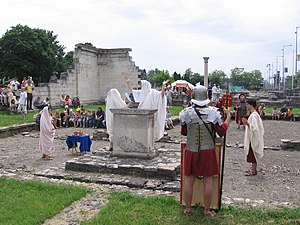Reconstructionist Roman religion
(Redirected from
Roman Polytheistic Reconstructionism
)This article needs editing to comply with Wikipedia's Manual of Style. (October 2015) |

Revivals of the ancient Roman polytheistic religion have occurred in several forms in modern times. Seeking to revive traditional Roman cults and mores, they have been known under various names including cultus deorum Romanorum (worship of the Roman gods), religio Romana (Roman religion), the Roman way to the gods (Italian: Via romana agli dei), Roman-Italic Religion and Gentile Roman Religion. A number of loosely related organizations have been created during the contemporary period.[1][2]
History
Interest in reviving
Italian unification led to anti-clerical sentiments in the intelligentsia. Some Italian intellectuals considered that a revival of Roman polytheism was a serious alternative to Roman Catholicism. People such as the archaeologist Giacomo Boni and the writer Roggero Musmeci Ferrari Bravo promoted the restoration of Roman cults and mores.[3][4] Some of the religious revivalists were interested in occultism, Pythagoreanism and Freemasonry; these included Amedeo Rocco Armentano, Arturo Reghini and Giulio Parise. In 1914, Reghini published the article "Imperialismo Pagano" (lit. 'Pagan Imperialism') where he argued for the existence of an unbroken initiatory lineage in Italy, connecting ancient Roman religion to modern times through people like Numa Pompilius, Virgil, Dante Alighieri and Giuseppe Mazzini.[5]
The attempts to revive or revitalize Roman cults coincided with the rise of the
Ur Group of the 1920s, various groups have appeared in Italy during the contemporary period, most notably the Roman Traditional Movement and Curia Romana Patrum in the 1980s, which unified some calendars.[7]
Inspired by the Roman Traditional Movement and by the
Latin Europe and in the Americas. The most notable international organization of reconstructionist Roman religion is Nova Roma, founded in 1998, which has active groups in every continent.[8]
See also
References
- ^ a b Marré, Davide (2008). "Tradizione Romana" [Roman tradition]. In Marré, Davide (ed.). L'Essenza del Neopaganesimo [The essence of neopaganism] (in Italian). Milan: Circolo dei Trivi. pp. 35–37.
- ^ Angelini, Andrea (22 January 2019). "The Roman Way To The Gods: The Ancients Are Back". Italics Magazine. Retrieved 28 August 2021.
- ^ ISSN 1743-1735.
- ISBN 978-1-3500-5686-2.
- ^ Giudice, Christian (14 October 2016). Occultism and Traditionalism: Arturo Reghini and the Antimodern Reaction in Early Twentieth-Century Italy (PhD). University of Gothenburg. pp. 19–20. Retrieved 19 August 2021.
- ISBN 978-90-04-15231-1.
- ^ Mark Sedgwick, Against the Modern World: Traditionalism and the Secret Intellectual History of the Twentieth Century, (2004) p. 187
- ^ George D. Chryssides, Historical Dictionary of New Religious Movements (2011, 2nd ed.)
Further reading
- ISBN 978-3-89913-688-3.
External links
- Nova Roma (international worldwide organization)
- Pietas Traditional Association (in Italian)
- Movimento Tradizionale Romano (in Italian)
